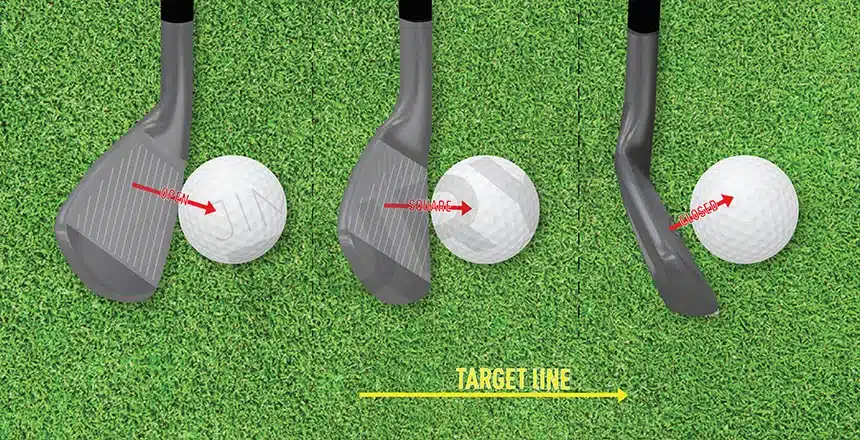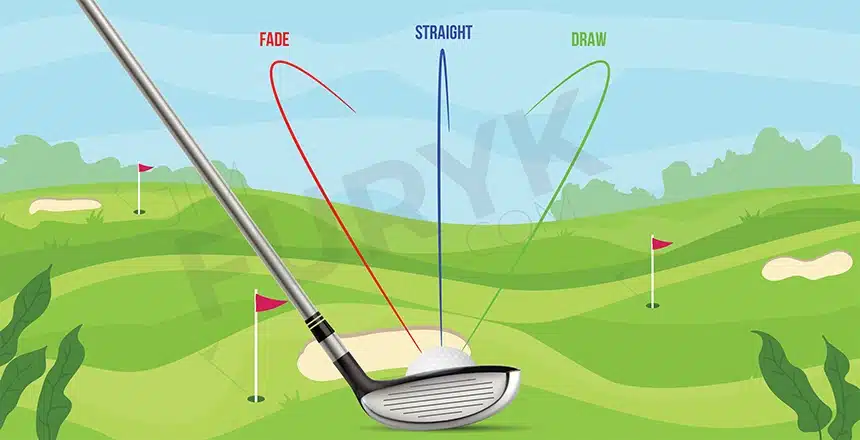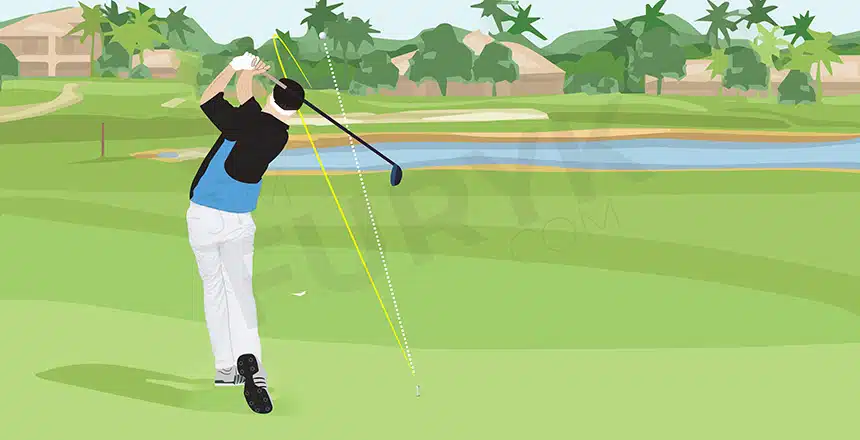Being able to hit a fade means you have what it takes to control how your shots travel. Fades also land very softly, so they don’t go rolling off the green or the intended target. And when compared to slicing the ball, fading actually saves strokes.
With a power fade, you attract less trouble in the form of fewer lost balls and fewer hazards. Ultimately, learning how to hit a fade in golf makes it so much easier for you to play more fairways.
With that in place, time to talk all about what a fade shot means, does, how it’s caused, how to hit one, and also how to fix a fade!
In This Post
What Is A Fade In Golf?
Cut shots or fades in golf take the form of ball flight shaped from the left to the right, for right-hand orientation (so that’s right-to-left for lefties).
A fade and slice are pretty much the same but in terms of appearance only. Fades are hit deliberately and with more control, whereas slices are unintended misses toward the right of the target.
A fade, unlike when you slice the golf ball, doesn’t cover a lot of lateral distance. For instance, when you, a right-handed golfer, play your tee shot in such a way that it moves from the left to the right by only a few yards, that’s exactly what a fade is. On the other hand, if your tee shots move offline (toward the right) uncontrollably, then it’s a slice.
Control is what gives fades the upper hand, control over golf ball direction, flight path, trajectory, distance, and the amount of roll when the ball lands on the turf. You even gain increased accuracy when you play a fade consistently. That way, you know where and how to aim, hence getting your shots closer to the target more frequently.
What Causes A Fade In Golf?
Simple and to-the-point – a swing path that’s outside-in is what leads to a fade. But just that alone won’t do it, the outside-in approach should also be combined with a neutral position of the clubface to your target line. This applies to right-handed players when they want to generate a left-to-right golf ball arc.
An open clubface at impact that is square to your target is what causes the right-oriented curving arc through left-to-right spin. While for left-handed golfers, that would become a left-curving arc because of the same left-to-right spin
Hitting A Fade – Why Do It or Learn How to Do It?
1. For Distance Control Consistency
You get more consistency with a fade than with a hook because the former, when hit well, can help you achieve adequate distance. On the other hand, in the case of hooks, they tend to “jump” and cover a longer-than-necessary distance.
Your shots traveling farther than expected means left and long, which welcomes the “out of bounds” penalty – the lowest of the lowest penalty in the game of golf.
Not many golfers also know and realize that greens, for the most part at least, have a back-to-front slope. So when over this green, short game turns into the most challenging aspect of your round.
2. For Softer Landing
Faded irons shots surely land much more softly than hooks and draws. Golfers who want that tucked pin to come closer often play a fade shot, and not a hook or draw. Because a hook or draw, in such a situation, consists of excessive spin that is decreed to release upon landing. Therefore, firm turf just cannot be played with hooks!
3. For Working Your Shots Both Ways
Ball flight can take the form of a hook or draw, right? Both come quite naturally to most golfers. On top of that, if you can learn how to create a fade as well, then you definitely have got more options during playtime on the golf course.
Hit a fade or draw then depending on the condition without feeling limited.
4. For Managing Your Missed Shots
Turning misses into good misses is a must because not every golfer hits his/her every shot flawlessly. So wouldn’t it be better if those poor or missed shots of yours also benefit you in some or the other way?
Misses that fade still remain in play, whereas poor ‘hooked’ shots spell nothing but trouble. And when it comes to lowering your handicap level or golf scores, you have to first and foremost prevent shots from running into hazards or the out-of-bounds penalty zone.
After all, bogeys are harmless, while quadruples, triples, and doubles will simply destroy your scores.
How to Hit A Fade With A Driver or Irons?
Some golfers hit a fade quite effortlessly because that slight, controlled curved-to-the-right ball flight or shot shape is very natural. On the other hand, there are those who end up hitting huge slices or sudden hooks instead.
So if you’re one of those unfortunate ones, it’s time to learn how you can hit more controlled fades with both your driver and irons!
1. Assess Your Grip
By assess, I actually mean weaken your grip because a grip that’s too strong can mess with your entire aiming game. When you want to hit a fade, the grip has to be a little bit weaker than your normal grip. Needless to say, this whole strong vs. weak grip has to do with how your hands are placed, and not grip pressure.
Here’s the complete guide for beginners on how to grip golf clubs the correct way.
Back to the point, refrain from forming a too strong grip, which involves keeping the top hand, i.e. left hand if you’re a right-handed golfer, slightly rotated counterclockwise. The aim here is to see not 3 but 2 knuckles on the top hand at the time of address.
However, don’t make the mistake of creating a too weak grip. How would you know? Not being able to square the clubface at impact, that’s how. Or you could just hold your golf club with your palm (the top part) more than your fingers. The bottom hand also rotates a little bit and in the same direction as the top one.
Simply bear in mind that 2 knuckles should be seen. If you see 4, know that you have a too strong grip. So keep adjusting the left hand till only 2 knuckles are in plain sight, which is surely going to help you accomplish the task of hitting a fade easily.
2. Open Your Stance
Be open to shooting a fade, and I mean that quite literally. Opening your stance is very important when trying to hit fades. Keep those feet parallel to the target line – this applies when hitting both straight and fade shots.
Even when hitting bunker shots, you ensure that the shoulders and feet are open and pointing toward the left of the target. So it’s pretty much the same in this case too.
Also, don’t forget that you need to be aiming slightly to the left of your intended target path to make room for your shot shape to initiate the slight left-to-right transition.
3. Visualize the Fade
Do you have a mental image of your shot? In simple words, do you have a target for hitting the fade? With irons, the target should be under 2-4 yards, whereas with your driver or fairway wood, it’s okay for the target to be closer to 10 yards.
Alignment in golf is one of the most basic and crucial aspects, which is why it’s so important to pick your target accordingly.
4. Open the Clubface

You don’t have to be a Jack Nicklaus to successfully hit a fade. This guy slightly opens the clubface at impact. But you necessarily don’t have to do that because fading the ball is something that can be achieved through the swing path as well.
The reason why Jack Nicklaus and golfers like him open the clubface for fades is that they find this particular fade-hitting approach more comfortable. But, for you, if changing your swing path feels more comfortable, go ahead and do that.
However, if you’re going with the ‘open clubface’ method, then make sure to open that clubface slightly. It all depends on how much curve you want the ball to produce. For more curve, open the face even more. Although an open clubface even by a degree is more than enough when it comes to generating a slightly curved ball flight.
5. Adjust Your Swing Path
Swing to the left, and swing from outside-in. Those not comfortable with opening that clubface should just try swinging toward the left. It’s all about cutting across the golf ball at the time of impact for creating the fade. Hence, hitting a fade from the inside.
When your swing path is an outside-to-in motion, the golf club hits the ball and then moves left (or right if you’re a leftie) through impact. During this stage, if the clubhead has taken on a more extended outside-in path, you end up cutting across the golf ball and hitting a slice. Instead, you ought to be attacking the ball from outside to in just by 1-2 degrees.
On the other hand, hitting a hook or draw requires you to adopt the inside-out swing approach. So it’s safe to say that the clubhead, during impact, largely decides the direction of ball spin.
6. Last But Not Least, Check Your Golf Equipment
There’s no sense in doing all of the above if you’re not using the right golf clubs. This is more specific to when using woods. If your woods feature the draw-biased setting, nothing you do is then going to produce a fade. Rather you want your driver to have a ‘fade-biased’ or ‘neutral’ setting. In that case, adjustable drivers go long way indeed.
If you tend to naturally draw the golf ball, it’s only normal to want to create a fade a little more frequently. For that, keeping the position “neutral” is a must. The clubface, if closed during address, will fail to hit a fade. So make it a point to check your equipment first and then employ the techniques discussed above.
7. Bonus Tip for Hitting A Fade Like A Pro!
I have two words for you, alignment sticks. Practice your fade shots with the help of some of the best alignment sticks in golf. These sticks are like a visual aid that’s highly likely to lead to you developing consistent shot-shaping capabilities.
With alignment rods, provided you know how to use them effectively, you can finally achieve proper alignment, a more controlled swing path/motion, and instant feedback in that you’ll feel your entire body rotation.
No matter how you want your shots to travel, this includes a fade, controlling your golf swing through the body is a must, and not through your hands and arms. And, no doubt, alignment sticks get you into the habit of making sure that your arms and body are well-connected and rotating in unison throughout your swing.
This means no more swaying and flipping the hands, thus a consistent swing pattern established, which is just what is needed for generating controlled shots i.e. controlled fades repeatedly.
How to Fix A Fade In Golf?
So here’s the thing, ball flight control can be extremely difficult to master in the game of golf. Only a few players, that too only Tour-level golfers, ultimately learn how to hit neat fades and draws whenever they wish.
Regardless, being able to eliminate fade-like shots from the golfing scene is always such a useful skill when, for instance, you have to deal with unfavorable conditions that loom in the direction of or on the side of the fade part of the course. Better then to keep the golf ball going throughout your round, right?
Wanting to get rid of unintended fades because of faulty or poor swing mechanics and fundamentals is actually quite common. And here’s how that can be fixed…
Understand the Problem – Why Are You Fading the Ball?
The most common cause is swinging the clubface across the golf ball, meaning producing an outside-in swing path with the clubface closed to your target line. Solid, center contact is certainly made, there are no two ways about that. However, when you strike the ball this way, on its nearest side to you or the inside, the clubface is obligated to create a fade.
What’s the Solution Then?
Swing more toward the right (if you’re a right-handed golfer) if you don’t want to produce a fade-inducing left-to-right ball flight. You may think that the ball is traveling down the target line but it’s really swinging toward the left. So to keep the ball flight in sync with your target line, you have to get yourself to feel as if you’re aiming or swinging to the right.
In a way, what you need to do is hit a draw, which is fade’s opposite. In this case, the golf ball begins toward the right but then curves back in the direction of the target. To achieve this, the ball has to fly like you’re actually swinging to the right, with a closed clubface that stays open to your target.
Instead of hitting a fade, you hit a draw simply by swinging or aiming more toward the right and also keeping the clubface closed and not open to the swing path. Easier said than done of course, but consistent practice should get you there eventually.
Fade vs. Slice – What’s the Difference?
The origin of a fade is the result of the clubface being open to your swing path at impact. Meaning if you’re a right-handed player, the clubface should be staring down the right of your swing path at the time of contact. So swing path is moving to the left of where that clubface is directed.
Fades are activated when the clubface is open to the swing path but closed to the target line. On the other hand, slices are generated when this clubface is open to not just your swing path but also to your target line. It’s the latter that starts the golf ball weakly toward the right and then gets it to curve further. That’s how a slice takes form.
But if you swing more to the left of the direction of the clubface, a fade will be created.
Fade vs. Draw – What’s the Difference?

Both fade and draw shots consist of sidespin, which is the major cause of the ball going slightly offline or off-center. Excessive sidespin, in most scenarios, is bad news. However, the least amount of this side-to-side movement i.e. sidespin (taking the form of a fade or draw) is sometimes better than just hitting a straight shot.
Also, many golfers have a natural tendency to fade or draw the golf ball, whereas those with advanced skills possess the talent to deliberately shape their shots this way.
So the main difference between fade and draw is the ball flight direction. Draws travel from the right to the left, while fades take on a left-to-right path. Both curved, lateral ball flight patterns are not too dramatic, they travel right-to-left (draw) or left-to-right (fade) only slightly.
Conclusion
The benefits of shot shaping in golf are very useful in that they ensure you avoid hazards during fairway play. When you know how to shape ball flight, your off-the-tee shots and approach shots turn out to be more successful.
As opposed to hitting a straight shot, a fade can actually bring you closer to that pin while also avoiding danger. On top of that, fading the golf ball generates greater overall spin, which makes sure the ball doesn’t roll off the green.

